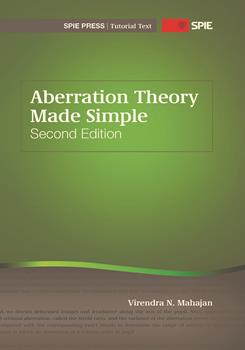|
In this chapter, we consider optical systems with circular exit pupils and discuss imaging by them based on the diffraction of object radiation at the exit pupil. Our starting point is an equation for the distribution of light in the image of a point object called the diffraction point-spread function (PSF) of the system. This equation is equally suitable for calculating the diffraction pattern of a circular aperture. Since, under certain conditions, the diffraction image of an incoherent object is given by the convolution of its Gaussian image (which is a scaled replica of the object) and the system PSF, the PSF calculations are fundamental to the theory of optical imaging. To understand the effect of aberrations on images, it is essential that we first understand the aberration-free PSF. Accordingly, we give briefly the characteristics of the aberration-free image of a point object. Our discussion on aberrated images is built slowly. First, we discuss defocused images and irradiance along the axis of the pupil. Next, approximate relationships between the ratio of the PSF values at its center with and without aberration, called the Strehl ratio, and the variance of the aberration across the pupil are developed. The approximate results for primary aberrations are compared with the corresponding exact results to determine the range of validity of the simple Strehl ratio formulas. The concept of aberration balancing is introduced in which an aberration of a certain order in pupil coordinates is mixed or balanced with one or more aberrations of lower order to minimize its variance, and thereby maximize the Strehl ratio of the system. Aberration tolerances based on a Strehl ratio of 0.8 are given for primary and balanced primary aberrations. Rayleigh's quarter-wave rule is briefly discussed, and balanced aberrations are identified with Zernike circle polynomials. The aberrated PSFs for various amounts of primary aberrations are given, and their symmetry properties in and about the Gaussian image plane are illustrated. Since the diffraction image of an incoherent isoplanatic object is given by the convolution of its Gaussian image and the PSF of the system forming the image, the spatial frequency spectrum of the diffraction image is given by the product of the spectrum of the Gaussian image and the optical transfer function (OTF) of the system. Thus, the OTF of the system, which is equal to the Fourier transform of its PSF, is equally fundamental to the theory of optical imaging. The OTF of an aberration-free system with a circular pupil is given, and how it is affected by an aberration is discussed. The concept of a Hopkins ratio, representing the ratio of the magnitudes of the OTFs at a certain spatial frequency, with and without aberration is introduced. Aberration tolerances based on a Hopkins ratio of 0.8 are given for primary aberrations. Finally, contrast reversal of certain spatial frequencies in an object is illustrated by considering their imaging by a defocused system. |
|
|


